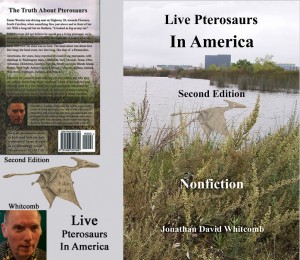My associates and I, including Garth Guessman and David Woetzel, have no confidence in Darwin’s philosopohy of unlimited evolution. In fact, we actively point out weaknesses in that idea. We do not portray a modern living pterosaur as disproof, by itself, of the General Theory of Evolution (unlimited common ancestry); but I believe that it will become part of the evidence that will eventually make it obvious that Darwin’s basic concept was incorrect. The eventual official scientific discovery of modern living pterosaurs will be part of a larger picture of life on earth, a life that did not originate by accident.
My associates and I do not dispute the obvious cases of limited evolution, for example the outward changes that have resulted in many breeds of domesticated animals or the different shapes or sizes of beaks of finches. We do dispute molecules-to-man evolution.
Evolution, Religion, and Extinction of Pterosaurs
“An Evolutionary Boundary” involves simple math, for a biologically saturated environment . . . the population calculations are simple. . . . After about six months of calculations, using computer programs I wrote myself, the original population of organisms of 10e29 (the number having “1″ followed by twenty-nine zeros), after only a few generations, had only a minute fraction of viable candidates for macro-evolutionary change.
Extinguishing Pterosaur Extinction
Examine the Western textbooks in detail. Where do you find any reference to any human experience regarding the extinction of even one species of pterosaur? Such a human experience is completely lacking, and the objection that it is impossible for humans to have witnessed any extinction of any pterosaur—that objection is irrelevant: The assumption of universal pterosaur extinctions comes not from any human experience. The point? How foolish to dismiss all human experiences, from around the world, that contradict a dogma of Western textbooks!
Live Pterosaurs in New Mexico
“It had a 20-30 foot wingspan and was about the same length long. It had a long tail with [a] seeming spike at the end. Its head was very pterodactyl shape with a fluted back pointy head. It glided at about 700 feet . . . and [it landed] somewhere on the southern expanse of Magdalena Mountains.” [in New Mexico]
Pterosaur in Arkansas
“It was probably 1982 when me and my older brother were sitting in our carport [in Texarkana, Arkansas] It was getting dark but there was plenty of light in the sky when we saw what we believe to be a pterodactyle [pterosaur]. The wingspan seemed to be about 25’ to 30’ ft wide. . . . an awesome sight to see.”
Kongamato Cryptid
The boy was walking from one mud-brick hut to another, one night in 1988, carrying a tray of food for family members. As he walked between the huts, he noticed something on the roof of his uncle’s hut. A creature was perched on the edge of the roof, lit up by the nearby porth light. The winged creature appeared to be four-to-five feet tall, olive brown, and leathery with no feathers. A “long bone looking thing” stuck out the back of its head . . .
Lack of Evidence for Extinction
Nothing in any scientific study or in any organized research of science has uncovered any evidence for the universal extinction of all species of pterosaurs. That idea is only a working assumption, regardless of fossils. On the other hand, the many eyewitnesses, from around the world, give evidence for several species of modern living pterosaurs, although most clear sightings involve a long tail like that of a Rhamphorhynchoid pterosaur.
A common misunderstanding, even among paleontologists, is that fossils of pterosaurs can be taken as if evidence for universal extinction. In fact, fossils are evidence of life in the past, not extinctions. And no combination of fossils, however they have been dated and however reliable that dating, can ever prove the universal extinction of a group of unlimited numbers of species, such as pterosaurs. That is unscientific dogma.
________________________________________________________________________

From readers of first edition of non-fiction cryptozoology book Live Pterosaurs in America (note this is now in the second edition, published late in 2010):
“[The] new book arrived today! . . . a wonderful job!!! . . . more sightings than they can dispute (21 states!!!) . . . a descriptive and engaging ongoing investigation . . .” Susan Wooten, who lives in South Carolina.
“This seems to be the author’s second book on the subject, and this one is worth the effort. He has focused on the accounts of witnesses who saw something, and that adds credibility. The writing is easy to read and he adds comments and analysis . . . more useful.” Red Rabbit, Cleveland, Ohio. [Five stars for the first edition]
“The problem with science is that we think we know it all and that is far from reality. This book shows courage to continue the search. If you have an interest in cryptozoology you should read this.” Dale Reeder, PA.
“This book is a great book! This book contains a lot of sightings and information on living pterosaurs. I highly recommend this book to anyone who is interested in living pterosaurs.” [from Amazon-anonymous child] A Kid’s Review [Five stars for the first edition]



